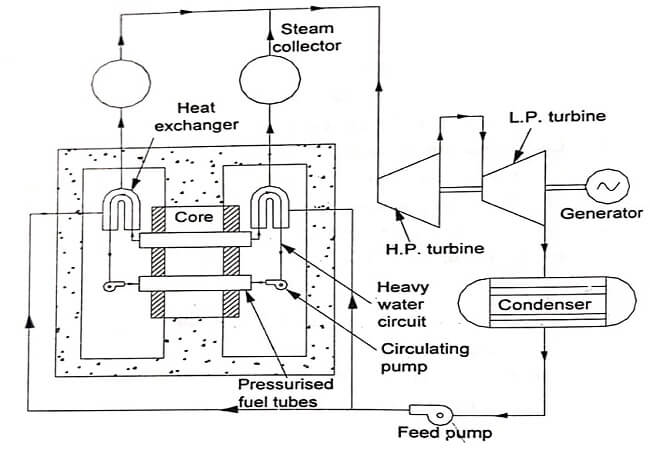Heavy water cooled and moderated type reactor (or) CANDU (Canadian Deuterium Uranium) Reactor:
This type of reactor was designed and developed in Canada. In this reactor, heavy water (99.8% deuterium oxide D2O) is used as moderator and coolant as well as the neutron reflector. These reactors are more economical to those countries which do not produce enriched Uranium as very costly. Natural Uranium (0.7% U235) is used as fuel in this reactor. The arrangement of CANDU reactor power plant is shown in fig.
The coolant (heavy water) is passed through the pressurised fuel tubes and heated up by nuclear fission. This hot coolant is passed through the heat exchanger where the heat is transferred to the feed water and steam is produced. By varying the moderator level, the reactor can be easily controlled and hence, control rods are not necessary. In this reactor, steam is generated at a temperature of about 265°C.
The reactor vessel and the steam generator system are enclosed by a concrete containment structure. For rapid shutdown purposes, the moderator can be dumped through a very large area into a tank provided below the reactor.
Advantages : CANDU
- There is no need of enriched fuel.
- Cost of the reactor is less for the construction of lighter reactor vessel to withstand low pressure.
- There are no control rods required.
- Construction period of this plant is shorter.
- Heavy water is used as a moderator which increases its effectiveness and provides low fuel consumption.
Disadvantages
- Heavy water is costly.
- Leakage of water is a major problem.
- Low power density (9.7kW/Litre)
- Very high standards are required for the design, manufacture and inspection.
| Read More Topics |
| Pressurised water reactor |
| Micro Hydro power plant |
| Cooling towers |
| Nuclear power plant fundamentals |
| Layout of nuclear power plant |






